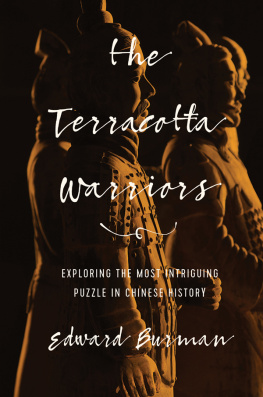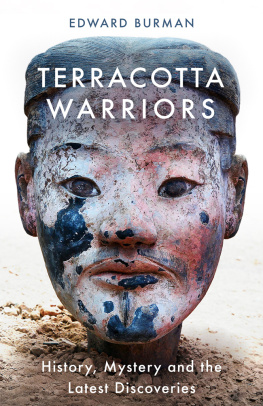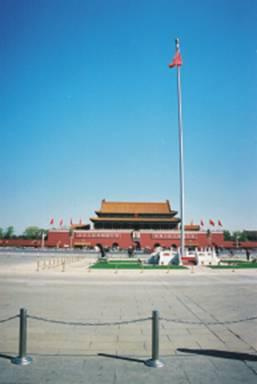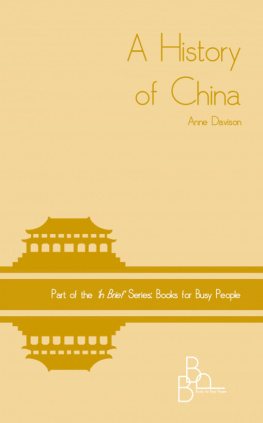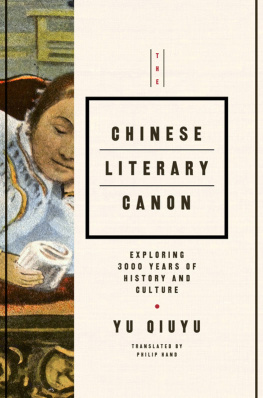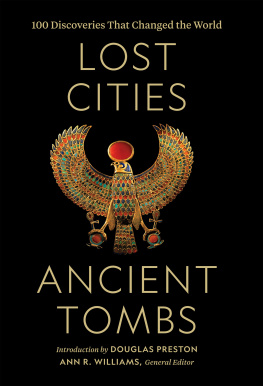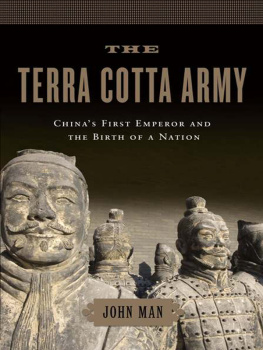

THE TERRACOTTA WARRIORS
Pegasus Books Ltd
148 West 37th Street, 13th Floor
New York, NY 10018
Copyright 2018 by Edward Burman
First Pegasus Books hardcover edition August 2018
All rights reserved. No part of this book may be reproduced in whole or in part without written permission from the publisher, except by reviewers who may quote brief excerpts in connection with a review in a newspaper, magazine, or electronic publication; nor may any part of this book be reproduced, stored in a retrieval system, or transmitted in any form or by any means electronic, mechanical, photocopying, recording, or other, without written permission from the publisher.
ISBN: 978-1-68177-796-2
ISBN: 978-1-68177-838-9 (e-book)
Distributed by W W. Norton & Company, Inc.
CONTENTS
Section l
Section 2
Section 3
Like most authors writing about China today, lve used the pinyin system of romanization of Chinese words. To make things easier for the general reader and to be consistent between text and quotes lve usually modernized, that is changed to pinyin, the place names and other names in early texts while giving the older Wade-Giles name in brackets or notes. Very occasionally, as in the case of the Qin capitals, lve added the Chinese name in brackets for clarity since a Chinese reader might not recognize some of the lesser-known places or books from the romanized form; old maps use very different forms of the names, and often those names have changed completely. There are several variant spellings of the name Qin, such as Chin or Chhin in English, Tsin in French (in Biot and Chavannes, for example) and Zin in Italian. Again, for consistency and clarity I have always used the form Qin even in quotations where others are used. There have also been many variants of the city name Xian during its long history, including Fenghao, Changan, Daxing, Fengyuan and Xi-Jing, and other spellings in European languages, for example, Hsien, Sian, Sianfu, Sigan Fu. I have used Xian throughout to avoid confusion. The unique French system of romanization used by Chavannes Pong-tcheng for Pengcheng, for example makes reading hard for those used to pinyin, or not used to Chinese names. Once again, for clarity and consistency I have modified the French names even in the quotations (references to the original are always given).
Since most of the events recounted here took place in the pre-Christian era, dates have been given throughout the text without the indicators BC or BCE to make it easier on the eye. The few dates later than the birth of Christ are given as AD, with the exception of obviously modern years from the nineteenth and twentieth centuries.
lve also followed convention on one potentially confusing matter. One of the seven major Warring States, an important neighbour of the Qin from the time when the older Jin territory was split into three, was that of the kings of Hann. But these Han had nothing whatsoever to do with the more famous and later Han dynasty which succeeded the Qin, so this book always uses the form Hann for the small ancient state and Han for the imperial dynasty to avoid misunderstandings.
There is also some possible ambiguity concerning the use of the words tomb and mausoleum and what is now sometimes referred to as a mausoleum complex which includes the terracotta warriors. For clarity, this book will use the following forms: Mausoleum Precinct (in the sense of a cathedral precinct), comprising the tomb, burial chamber, funerary mound, and the area within the Inner Wall; the Area Immediately Surrounding the Mausoleum Precinct, inside and around the Outer Wall; the Terracotta Warriors (which form a distinct entity 1.5 kilometres east of the mausoleum); and the capitalized form Mausoleum to include the entire area planned by the First Emperor for his afterlife.
My debt to scholarly authors is clear from the Bibliography, and, having been introduced to French sinology through a study of the exploits of Victor Segalen in China for a documentary film, I would like to add that I make no excuse for using the very old work of douard Biot (1803-40), and that of Segalens teacher at the Collge de France, douard Chavannes (1865-1918), both profound scholars of classical Chinese whose detailed notes often provide significant insights (the same is true of James Legges notes to his nineteenth-century translations of the Confucian texts). Chavannes actually visited the location in 1907 without knowing it, and inspired Segalen to take his famous photograph of the site seven years later following indications from his mentors translation of the Han historian Sima Qian, whose work is the primary source of information about the Qin. The letters between Chavannes and Segalen make fascinating reading on the mausoleum. All quotations concerning the Qin from Sima Qian have been translated/adapted by me from the chapters of Chavannes work, Les Mmoires historiques, published in French in five volumes between 1895 and 1905, except a few from Burton Watsons modern translation, in particular from chapters on the Han dynasty which were not translated by Chavannes (Records of the Grand Historian, Han Dynasty I and Han Dynasty II, 1993). I have also consulted, but not quoted from, the multi-author translation edited by William H. Nienhauser, in particular volume I, The Basic Annals of Pre-Han China (1994), dedicated to Chavannes, and volume II, The Basic Annals of Han China (2002), dedicated to Burton Watson.
The objective has always been to provide a clearly comprehensible English version. Translations of passages from Chinese scholarly reports have been privately made for my personal use, and any uncertainties discussed with the authors when possible. Translations from other languages are my own.
The existence of a mausoleum built for Qin Shihuang, who is better known outside China as the First Emperor, has been recognized since fairly soon after his death over 2,200 years ago. For the story of its construction was related in a celebrated chronicle of ancient Chinese history, whose title is usually translated into English as Records of the Grand Historian or Records of the Scribe, written on bamboo strips by the Grand Historian (also known as Grand Astrologer) at the court of Emperor Wu of the Han dynasty, Sima Qian (145-86). He described the process as follows:
From the beginning of his reign Shihuang had Mount Li built and shaped. Then, when he had united the whole empire in his hands, he had seven hundred thousand workers transferred there. They dug down until they reached the water level and poured in bronze to make the sarcophagus.
But the precise location of the funerary mound and its underground tomb were unknown to the ancient Chinese because it had been deliberately hidden. Unlike mausoleums designed to be admired from afar, such as the Taj Mahal in Agra or the Panthon in Paris, this product of the long-term labours of such a vast workforce was always intended to be made invisible after the burial. Once the thousands of artefacts and treasures which would enable the Emperor to continue his terrestrial life into eternity had been placed in the ) were to be locked inside to die with him. Trees and bushes were then planted over the site so that it would resemble another mountain in an already mountainous landscape.
Legends and rumours abounded through the centuries; some local villagers may have known or guessed what it was, but failed to imagine its significance in a landscape dotted with funeral mounds, imperial tombs and ancient ruins. The exact location was identified and roughly surveyed in the Ming period, around the time of the Italian Renaissance, and it was photographed by two foreign travellers just over a century ago; but meaningful knowledge dates only from the 1960s. Superstition and fear and the presence of mercury, known from Sima Qians account and to be discussed later seem to have provided immunity through the centuries from the grave-robbers and dealers who ransacked other tombs.
Next page
